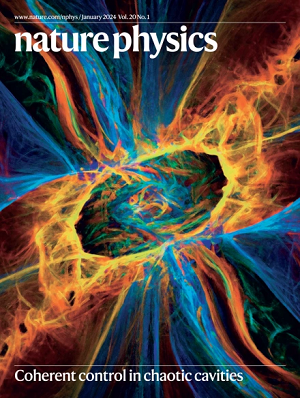Odd-parity quasiparticle interference in the superconductive surface state of UTe2
IF 18.4
1区 物理与天体物理
Q1 PHYSICS, MULTIDISCIPLINARY
引用次数: 0
Abstract
Although no known material exhibits intrinsic topological superconductivity, where a spin-triplet electron pairing potential has odd parity, UTe2 is now the leading candidate. Generally, the parity of a superconducting order parameter can be established using Bogoliubov quasiparticle interference imaging. However, odd-parity superconductors should support a topological quasiparticle surface band at energies within the maximum superconducting energy gap. Quasiparticle interference should then be dominated by the electronic structure of the quasiparticle surface band and only reveal the characteristics of the bulk order parameter indirectly. Here we demonstrate that at the (0–11) cleave surface of UTe2, a band of Bogoliubov quasiparticles appears only in the superconducting state. Performing high-resolution quasiparticle interference measurements then allows us to explore the dispersion of states in this superconductive surface band, showing that they exist only within the range of Fermi momenta projected onto the (0–11) surface. Finally, we develop a theoretical framework to predict the quasiparticle interference signatures of this surface band at the (0–11) surface. Its predictions are consistent with the experimental results if the bulk superconducting order parameter exhibits time-reversal conserving, odd-parity, a-axis nodal, B3u symmetry. UTe2 is a proposed intrinsic topological superconductor, but its quasiparticle surface band has not yet been visualized. Now this is achieved using quasiparticle interference imaging, revealing the symmetry of the superconducting order parameter.

UTe2超导表面态的奇宇称准粒子干涉
虽然没有已知的材料表现出内在的拓扑超导性,其中自旋三重态电子对势具有奇宇称,但UTe2现在是主要的候选者。一般来说,超导序参量的宇称可以用波格里乌波夫准粒子干涉成像来确定。然而,奇宇称超导体应该在最大超导能隙的能量范围内支持拓扑准粒子表面带。准粒子干涉应以准粒子表面带的电子结构为主导,只能间接地揭示体序参数的特征。我们证明了在UTe2的(0-11)劈裂表面,Bogoliubov准粒子带仅在超导状态下出现。进行高分辨率准粒子干涉测量之后,我们可以探索超导表面带中状态的色散,表明它们只存在于投射到(0-11)表面的费米动量范围内。最后,我们建立了一个理论框架来预测该表面带在(0-11)表面的准粒子干涉特征。如果块体超导序参量表现出时间反转守恒、奇宇称、a轴节点、B3u对称性,其预测结果与实验结果一致。UTe2是一种被提出的本征拓扑超导体,但其准粒子表面带尚未被可视化。现在这是通过准粒子干涉成像实现的,揭示了超导序参量的对称性。
本文章由计算机程序翻译,如有差异,请以英文原文为准。
求助全文
约1分钟内获得全文
求助全文
来源期刊

Nature Physics
物理-物理:综合
CiteScore
30.40
自引率
2.00%
发文量
349
审稿时长
4-8 weeks
期刊介绍:
Nature Physics is dedicated to publishing top-tier original research in physics with a fair and rigorous review process. It provides high visibility and access to a broad readership, maintaining high standards in copy editing and production, ensuring rapid publication, and maintaining independence from academic societies and other vested interests.
The journal presents two main research paper formats: Letters and Articles. Alongside primary research, Nature Physics serves as a central source for valuable information within the physics community through Review Articles, News & Views, Research Highlights covering crucial developments across the physics literature, Commentaries, Book Reviews, and Correspondence.
 求助内容:
求助内容: 应助结果提醒方式:
应助结果提醒方式:


